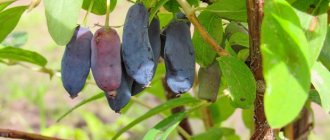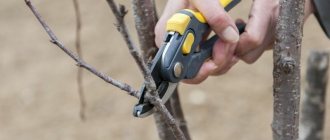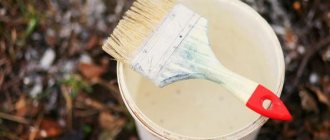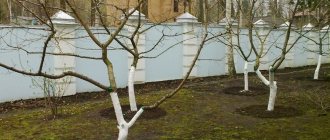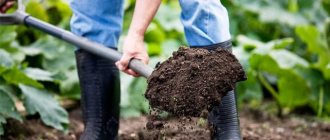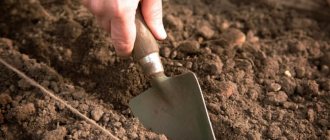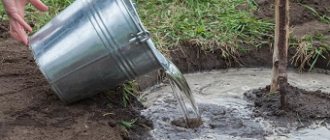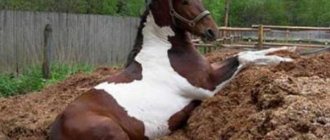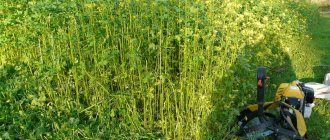Category: Organic fertilizers Reading time: 12 min · Views: 3,806
Manure is one of the most popular types of organic fertilizer among gardeners. Farm animal droppings introduced into the soil improve its structure and quality composition, making the soil loose and breathable. But in order for organic fertilizing to be as beneficial as possible for agricultural crops, you need to know how to apply manure.
Physical and chemical properties of fresh manure
The main components of any animal excrement are water and organic matter digested in the gastrointestinal tract.
During chewing, animals grind food and mix it with saliva, which moistens the food and also fills the mixture moving through the esophagus with enzymes necessary for the primary breakdown of organic matter.
As food moves through the gastrointestinal tract, it is exposed to various enzymes that break down complex organic matter into simple saccharides or other substances suitable for feeding bacteria living in the gastrointestinal tract.
These bacteria are one of the most important elements of the digestive system, because they secrete the enzymes necessary to convert broken down organic matter into substances suitable for absorption through the intestinal walls.
The food that passes through the gastrointestinal tract is a complex mixture :
- organic breakdown products;
- intestinal enzymes;
- substances that are waste products of bacterial activity;
- incompletely digested food fragments in which bacteria were able to ferment only the outer layer;
- bacteria involved in the activity of the gastrointestinal tract;
- eggs of helminths (worms);
- pathogens of various diseases;
- weed seeds that survived the action of enzymes and retained their similarity.
Timing of application to the soil
The question of when is the best time to apply manure to the ground worries many farming enthusiasts.
When adding organic matter during autumn digging, all nutrients necessary for the normal functioning of plants are included in the soil. Thanks to this, green crops receive the necessary substances, which are the result of the breakdown of the organomineral complex, throughout the entire growing season.
In autumn, the process of decomposition of organic matter occurs slowly, this allows active biological microorganisms to most effectively consume nutrients and produce humus, which increases soil fertility.
When fertilizers are applied to the soil in the spring, all useful substances are primarily consumed by plants. At the same time, the fertility of the land practically does not increase.
That is why experienced agronomists recommend adding manure during digging in the fall, and in the spring delighting the plants with liquid infusions (to which you can also add ash or bone meal).
What processes take place in it?
Many processes occur simultaneously in fresh excrement, but the most important for gardeners are the following:
- rotting;
- loss of moisture;
- loss of nitrogen.
Rotting
Rotting is a natural mechanism of the cycle of substances in nature, thanks to which any organic matter returns to the beginning of the cycle and becomes plant food.
Active participants in decay are:
- many types of bacteria;
- various mushrooms;
- worms
Each of the participants in this process has its own metabolism, due to which it uses different chains of transformations of one substance into another, which provides different properties of humus, which is a waste product of their vital activity. Therefore, the more species of living beings are involved in the process of decay, the more balanced the resulting humus will be.
Mandatory conditions for the activity of these living creatures are a sufficient level of humidity and a temperature within the range of 10–40 degrees Celsius.
Some types of bacteria remain active even at a temperature of 65 degrees , but for most participants in the process, heating above a temperature of 40 degrees leads to death or a sharp decrease in activity. Therefore, thermal drying and granulation of fresh manure suppresses the activity of all participants in the rotting process and preserves all organic matter intact.
In addition, some types of b
The actors involved in the process of decay raise the temperature of the substrate to comfortable values. This effect is often used to warm the soil or accelerate decay.
Loss of moisture
There are 2 main reasons for moisture loss:
- absorption into the soil;
- evaporation.
From manure lying on the ground , part of the water goes into the soil, taking with it some enzymes and various compounds that have the same toxicity as excrement.
Therefore, pustules, that is, areas of fields intended for rotting or storing manure, are used for growing plants only after 5–7 years, when the toxic substances gone with the water have completely rotted.
Water molecules do not have a rigid connection with each other, so the kinetic energy of their movement and collision pushes individual molecules out of the total mass, which is why they escape into the atmosphere in the form of vapor. Along with water molecules, manure loses molecules of ammonia and other nitrogen-containing substances , but at a slower rate, so the greatest losses of these substances occur during long-term storage of manure.
Nitrogen loss
Fresh manure contains nitrogen in the form of various compounds, some of which are volatile, so they gradually evaporate into the atmosphere.
During drying of any kind, excrement loses ammonia and skatole, substances that have a very strong odor and high toxicity, so material that has lain for several months produces a very weak odor, while dry material is completely free of unpleasant odor .
Another part of the nitrogen goes into the soil along with the seeping liquid, but the greatest losses of this material occur due to the activity of humus-forming bacteria that feed on compounds of this element.
Humus and compost: what are the differences?
Many novice amateur gardeners cannot distinguish between compost and humus.
For example, they may call the contents of a regular compost heap humus. Let's try to figure this issue out together and clarify things. Let's take a brief look at the origins of these types of fertilizers.
What is a compost heap? This is a specific place where organic waste from the garden is placed, where it gradually decomposes.
Compost consists mainly of organic waste, for example, sawdust, chopped coarse branches, and food waste that were not eaten are used. For this reason, when ripening, the compost does not have a uniform structure.
Humus is a substrate that was obtained during the decomposition of domestic animal waste and plant residues.
The humus mass is prepared only using manure from any animals (usually mullein) and organic matter that quickly decomposes (leaves, grass). When ready, it has a homogeneous structure.
Freshness levels
Processes occurring in fresh manure change its characteristics and chemical composition, which changes its effect on plants and soil.
Therefore, conditionally, manure can be
divided according to the degree of freshness into :
- fresh;
- stale;
- very stale;
- partially rotted;
- humus.
fresh if no more than a week has passed since the animals excreted it, because during this period the processes occurring in it do not have time to change the properties of the material.
Stale material is considered to be a material whose shelf life does not exceed two months, during which it manages to lose a certain amount of nitrogen and moisture, and bacteria process part of the organic matter into intermediate substances that are not yet humus.
very stale if its shelf life does not exceed 6–8 months, because it has already lost almost all the properties inherent in fresh excrement, but still retains a little toxicity and contains almost no humic acids.
Partially rotted manure is considered to be manure that has lain for about a year, during which time it completely loses its toxicity, and bacteria manage to process some of the organic matter into humic acids. Humus is considered to be material that has lain for 2 or more years.
Manure as fertilizer: types, composition, properties
Depending on the type of animal from which the waste is obtained, manure can be:
- horse;
- bovine;
- rabbit;
- avian;
- sheep;
- pork.
Each type of manure has its own composition and characteristics, and it also differs in the duration of its effect on the soil.
Pig manure is rarely used because it contains a large number of helminths. Cow dung is most effective. On light sandy soils, the effect of manure remains for 2-3 years, on heavy clay soils - 4-6 years.
Horse dung. It has a rich chemical composition. Suitable for use in greenhouses and open ground. Poultry manure (droppings) is the fastest-acting fertilizer. Convenient to use for fertilizing.
Beneficial properties of manure
Manure is based on animal excrement mixed with grass, straw, and sawdust. There are several categories of manure according to the degree of decay:
- Fresh manure. This is a thick fertilizer that easily holds its shape.
- Slurry. Slush is used most often. This is a nitrogen-potassium fertilizer suitable for fertilizing vegetable and garden crops. The slurry is diluted 1:5 and added after watering. Used when laying compost to moisten the soil.
- Semi-rotted manure. This is manure that has been lying in the open air for about six months. It crumbles easily in your hands. Used as a fertilizer for digging on depleted soil.
- Humus (rotted manure). Loose, completely bent loose mass. The most common fertilizer. Rotted manure contains a lot of nitrogen and nutrients, 2 times less than fresh manure.
You may be interested in: Blood meal as a fertilizer, methods of application
Is “fresh” manure always really that way?
When buying “fresh” manure or receiving it for free, you need to make sure that it is not stale or partially rotten, because each type of excrement has special properties and affects the soil or plants differently . Neither type is worse than the other, it’s just that each of them is suitable only for certain purposes.
For example, only fresh or slightly stale material is suitable for heating the soil in the beds, because it retains a sufficient amount of organic matter necessary for bacteria to release the required amount of heat.
Therefore, when purchasing manure, you need to find out from the seller or supplier the time and storage conditions , because the properties of the manure, and therefore the method of its use, depend on this.
Most of the cases, as a result of which the seemingly correct use of fresh manure did not have the desired effect or destroyed the plants , is due to the fact that the shelf life of this material was not taken into account, and therefore its properties, which change over time.
Where can you use compost? Scale of compost production
Depending on the scale, composting can be centralized or private.
A plant producing compost from organic and agricultural waste in rural Germany. Compostable material is piled
Centralized composting is carried out by local governments, waste processing enterprises, agricultural holdings, etc. Centralized anaerobic composting in industrial volumes is carried out in the field or on.
In Russia and the CIS countries, the proposed technology for the production of multi-purpose compost (MPC), produced by accelerated composting of manure, poultry droppings and other substrates in special biofermenter chambers in aerobic solid-state fermentation mode, has become widespread. This technology is classified by the Ministry of Agriculture of the Russian Federation as the best priority proven basic technology.
Private composting is carried out by homeowners on their personal plots, backyards, vegetable gardens, or in public composters, if they are located nearby. For this purpose, compost bins, heaps, and composters located on the site are used. Some gardeners use composting technology directly in the beds where crops are grown. There are also technologies for indoor composting, although this requires special technologies to ensure the process is hygienic (for example, the use of additives).
Can it be used in the country house and garden?
Every experienced gardener or gardener knows that fresh manure is a very dangerous substance that kills any plants and also generates heat when rotting.
Therefore, it can be used in the garden, but only where it does not come into direct contact with any parts of plants , and therefore cannot harm them.
In addition, it is very important to correctly determine the age of manure, because over time its properties change and it loses not only toxicity, but also the ability to generate heat when rotting.
Methods of application
This material can be used in the following ways :
- fertilization of fallow areas;
- soil heating;
- adding seeds or seedlings to the holes before planting;
- production of liquid fertilizer;
- making humus;
- compost production;
- fertilizer for indoor flowers.
Fertilizing fallow areas
Fresh excrement poses a serious threat to plants, but it also provides food for many soil inhabitants that participate in the soil restoration process. One of these inhabitants are dung and earthworms , which smell fermented, rotting organic matter from afar and crawl to the source from all over the area.
By eating organic matter that is part of excrement, worms perform several important functions :
- loosen the soil, increasing its ability to pass water;
- digesting organic matter, they produce humic acids and various humates;
- They clear the soil of any plant remains, which also become their food.
Therefore, fertilizing with fresh manure not only fills the soil with nutrients, but also increases the efficiency of the soil regeneration process, without which it is impossible to obtain good harvests.
This fertilizer is carried out before autumn plowing after harvesting or growing green manure . Manure is spread over the site either manually (delivered by wheelbarrow, then spread with a shovel and leveled with a rake) or using a tractor manure spreader.
The thickness of the layer depends on the availability of fertilizer and the degree of depletion of the soil, usually 1–10 cm. Moreover, the thicker the layer, the more measures must be taken to ensure that it has time to rot before sowing. Therefore, as a top dressing in non-depleted areas, the layer thickness does not exceed 5 cm, but if the soil is very depleted, then 10 cm is poured.
Immediately after spreading the fertilizer over the ground, the area is dug up or plowed, and the depth of the shovel or plow share should be at least three times the thickness of the layer of fresh manure.
You cannot use walk-behind tractors for digging , because almost all of them are made of materials that are not highly resistant to acids, which means contact with excrement will lead to corrosion of metal parts.
If acids damage a shovel or ploughshare, then replacing them will cost many tens of times less than repairing or replacing a walk-behind tractor.
For such fertilizer, manure with any shelf life is suitable, however, the fresher it is, the more strongly it will attract worms, which means the soil will acquire a better structure.
The only disadvantage of this method is that before applying it to the fields, the manure must be crushed, because the larger the pieces, the more time they will need to rot. Most manure spreaders effectively crush the material, so they can even be loaded with dried dung or granulated manure, but when using dry excrement, it is necessary to thoroughly water the area after applying and digging it.
Under natural conditions, humus from manure is obtained in 2–3 years, and in some cases it takes at least five years, therefore, by applying such fertilizer to the fields before leaving them fallow, it is necessary to reduce the time of decay so that the process is completed before the start of sowing.
For this, a fertilized field:
- plow 2–5 times a year;
- treated with bacterial preparations, which we talked about in this article;
- Water every month so that the humidity level does not drop to a level dangerous for bacteria.
Soil heating
When planting seeds or seedlings, the soil temperature is of great importance, because if it is too low, both the seed and the seedlings will most likely die.
In order to plant seeds and seedlings earlier than the outside temperature allows, it is necessary to heat the soil, thanks to which the plants will develop in favorable conditions and by the time the soil naturally warms up they will have time to strengthen and gain strength.
Heating the soil will be most effective in a greenhouse, because even without heating it will allow seeds or seedlings to be planted 1–2 months earlier than in open ground, which means that the fruits will ripen earlier, after which it will be possible to replant the seedlings and harvest a second harvest before frost .
To organize the heating of the beds, the entire fertile layer is removed from them, then holes or trenches are dug . The optimal dimensions of the pit are 1x1x1 m (length, width, depth), the trenches are made the same, only of the required length.
You can make smaller holes or trenches, but then they will not be able to warm up the separating and fertile layers of soil, so such fertilizer will not provide the expected benefit.
The bottom and walls of a hole or trench must be insulated using dry grass or dung , this will reduce heat loss, due to which more heat will be spent on warming the separating and fertile layers of soil. In addition, in holes or trenches without insulation it is much more difficult to start the process of rapid decay, which is often called “combustion”.
After insulating the walls and bottom, fresh manure is loaded into the hole or trench. It is not worth using even slightly stale material for this operation , because it will heat noticeably worse, because the bacteria have already completed part of their task, which means that not all microorganisms will participate in the process. If you load it with stale manure, the energy released by the bacteria will not be enough to warm up even the separating layer of soil.
Then a “burning” reaction is started in the manure using bacterial preparations and hot stones or warm water. A detailed description of the launch, as well as changes that will help track the beginning of this process, can be found here.
As soon as combustion begins, the manure is immediately covered with a separating layer of soil, and the thickness of the layer should be 5–15 cm, after which a layer of fertile soil is poured. The total thickness of the separating and fertile layers should be such that the lower ends of the most developed roots are 1–3 cm above the manure.
Application into holes before planting seeds or seedlings
This method of using fresh manure accelerates the development of plants, and also strengthens their immunity and makes them more fertile.
Before planting seeds or seedlings, the hole is deepened by 15–30 cm, then 10–25 cm of fertilizer is poured, and the younger the manure, the less it needs to be poured, because it will rot in 1–2 years, so the roots of the plant at this time should not reach it to avoid nitrogen burn.
After pouring manure, you need to sprinkle it with several grains of ash, this will neutralize the change in soil acidity. If seeds or seedlings are planted not in holes, but in grooves (trenches), then they are also deepened and fertilizer is first poured in, then sprinkled with ash. Then pour a separating layer of soil 1–3 cm thick and fill the trench or hole with fertile soil.
The maximum result will be achieved if, instead of fertile soil, you pour soil mixture into the holes or grooves , that is, fertile soil mixed with humus or sapropel and sand.
Preparation of liquid fertilizer
Plants cannot be fertilized with fresh manure, so if signs of a lack of nutrients or microelements are detected, a liquid fertilizer is made from fresh manure, which is much less toxic and is well suited as an emergency aid .
However, liquid fertilizing cannot replace normal fertilization of the site, as well as various agrotechnical measures that restore the structure and chemical composition of the soil.
To make liquid fertilizing, perform the following operations :
- Fresh, stale or heavily stale manure is poured with a small amount of water so that after liquefaction, a paste is obtained, the consistency of which is similar to thick kefir or liquid sour cream, and the faster you need to get fertilizing, the more liquid the solution is made. This solution is often called a concentrate.
- The solution is kept in a suitable container for several weeks in a well-lit place until partially or completely rotted. A sign of partial rotting is a persistent swampy smell and a decrease in the number of bubbles released over a certain time. A sign of complete rotting is a persistent earthy smell and a complete absence of bubbles.
- Partially or completely rotted paste is diluted with water to the required concentration and, if necessary, filtered. The resulting solution is used to feed plants.
Making humus
Making humus is the safest way to use fresh manure, because humus, also known as humus, is the final link in the cycle of substances in nature.
The transformation of excrement into humus is a natural process that occurs due to the activity of humus-forming microorganisms.
Therefore, the task of a gardener or gardener who needs to turn excrement into fertilizer is to create the most favorable conditions for these microorganisms.
To do this, do the following :
- they put excrement in piles and periodically moisten and turn them, this mixes the areas of the pile that have already been processed by bacteria and have not yet been affected, due to which the bacteria gain freer access to the substrate;
- they put manure in insulated containers or pits, which reduces the loss of heat generated by bacteria, which means microorganisms will be able to work in a more efficient thermophilic mode;
- treat excrement with bacterial preparations.
Making compost
Compost differs from humus in that it is obtained from a mixture of manure with various plant residues.
Humus from compost is more balanced and has a better effect on soil structure than that obtained from manure, because even when rotted, plant residues effectively perform the function of sand, improving the soil’s ability to conduct water, and also contain substances destroyed in the gastrointestinal tract of animals.
To obtain humus from compost, the same methods are used as when working with manure, the only difference is that the compost must be laid in layers, that is, layers of excrement alternate with layers of chopped vegetation, which can be collected in the garden.
Fertilizing indoor flowers
Indoor plants do not participate in the cycle of substances in nature , because leaves do not fall on the soil in which they grow and animals do not defecate, which means that bacteria and worms cannot convert these materials into humic acids.
Therefore, after a few years, the soil in the pot becomes poorer, which negatively affects the plant.
To prevent such developments and extend the life of the soil, plants must be fertilized with fresh or any other manure.
To do this, you will need a deeper pot that can accommodate a layer of manure and a layer of separating soil. The thickness of the manure layer depends only on the depth of the new pot, however, the thickness of the separating layer depends on the type of manure and should not be less than :
- 10 cm for fresh;
- 5 cm for stale;
- 1–2 cm for heavily stale ones.
Creating warm beds
In warm beds it is possible to grow early plants in the spring. The method is based on using the heat generated by organic matter to warm the roots. Thanks to this, plants can more easily tolerate temperature changes at the beginning of the season. When manure decomposes in a warm bed, carbon dioxide and beneficial substances are released that have a beneficial effect on vegetable crops, flowers and strawberries. Plants develop earlier, bear fruit faster and longer, and the yield increases several times.
The process of forming a warm bed is simple. The bottom layer consists of materials that are difficult to decompose - cardboard, tree branches, stems, paper. Next - tops, vegetable and fruit waste, shells, sawdust, straw. The top layer should consist of quickly rotting organic matter (leaf or grass). Each of these layers must be sprinkled with manure and spilled with warm water.
If a warm bed is made in the fall, you can use any manure, even fresh manure. Rotted excrement is suitable for formation in the spring. Horse manure is best suited for these purposes, but cow manure mixed with sawdust can also be used. The warm bed is filled with fertile soil from above. Such a platform can be used for 3-4 years, after which the contents must be replaced.
Warm beds can be placed in open ground or in greenhouses. In the second case, the cost of heating the room will be significantly reduced. If you put arches on such a bed and cover it with covering material, you will get a wonderful greenhouse in which you can grow early plants.
What crops like fresh manure?
Some gardeners believe that there are plants that love fresh manure, and it can be applied to these crops. But it is important to understand that truly fresh manure, that is, produced by animals less than a week before use, is destructive for any plants , however, “fresh” often means something that has just been purchased or delivered, but has not yet rotted.
In addition, much depends on the time of application, because all plants will grow much better if the field is fertilized with fresh manure before leaving it fallow.
But if you add it to the beds in the fall, and the next year plant seeds or seedlings here, then there will not be a single plant that can grow normally in such soil. Therefore, we can say that any garden or vegetable plant loves fresh manure if the gardener or gardener uses it correctly.
How to apply it in the fall?
The method of applying manure in the fall depends on the subsequent use of the site - if it is left fallow, then it is enough to scatter the fertilizer over its surface and then dig it up, but if in the spring it will be used for planting seeds or seedlings, then the excrement must be prepared.
The fastest ways to prepare are:
- hot composting with treatment with bacterial preparations;
- production of fertilizer concentrate.
For hot composting, manure and chopped garden vegetation are placed in layers in an insulated box or insulated pit. To grind it, you can use one of the devices that we talked about in this article.
The compost is then watered with water and bacterial preparations, after which it is covered with a tarpaulin to reduce heat loss and reduce air access. Every 2-3 days the mixture is thoroughly stirred . After 2-3 weeks, such compost is ready, so it is spread over the site manually or using a manure spreader, then the site is plowed, watered and treated with bacterial preparations.
The concentrate is made in the same way as described above, in sunny weather it is kept for 7 days, in cloudy weather for 10, then applied to the fields without diluting with water, and after a week the area is plowed or dug up.
Fertilizing will be more effective if, together with excrement, you use chopped garden or vegetable vegetation , the same weeds or mowed grass. Top dressing with crushed vegetation not only saturates the soil with organic matter and attracts worms, but also has a beneficial effect on the structure of the soil, because even highly crushed plant residues perform the same function as sand, that is, they increase the ability to pass water.
How to apply in spring?
If the manure is not stale, but really fresh, then it can be applied in the spring only to an area left fallow, after which it must be immediately plowed and treated with bacterial preparations .
If there are any necessary plants on the site, then fresh manure can be added only after it has been converted into liquid fertilizer or humus. If the “fresh” manure turns out to be very stale or almost rotten, then it can be laid out in a ring around mature strong plants, stepping back from them by 5–15 cm.
This way, it will not harm the trunk and will fill the soil with microelements, and after rotting, which can be accelerated by treatment with bacterial preparations, heavily stale manure will restore the humic acids lost by the soil.
Most often, this method is used to fertilize trees and shrubs , because even if it rains soon, which will push the manure towards the trunk, the bark will protect the wood, which cannot be said about annual plants.
Fresh excrement and soil acidity
When fertilizing the soil or plants in the spring with fresh manure or products derived from it, it is necessary to monitor the acidity of the soil to avoid acidification.
This can be done using a garden pH meter, then, if the soil turns out to be too acidic for the selected or planted plants, one of the following substances is added to it:
- ash;
- dolomite flour;
- chalk;
- lime.
Such a check is required before planting seeds or seedlings, because unlike adult plants, they cannot withstand high acidity and will quickly die .
If the acidity is optimal for the plant, then it will develop quickly and actively, and also suffer less. In addition, it is necessary to check the prepared soil mixture with a pH meter and, if necessary, adjust its acidity.
Other uses in the garden
The shelf life of fresh manure is short, because bacteria process it around the clock, and the rate of their reproduction is directly proportional to the amount of food, which is animal excrement for them.
However, for some work, fresh material is needed, with the maximum amount of initial organic matter, so one of the most popular ways to use manure is to dry it, after which dung or granules are obtained .
Owners of greenhouses equipped with air or water heating will be able to use dried excrement as fuel. This type of fuel is noticeably inferior to wood or coal, but you don’t need to buy it, and burning it helps to get rid of accumulated and unpleasantly smelling piles of this “good.”
There is another method that is used where all the plants are planted in beds, and wide row spacing is left between the beds.
A groove is dug along the entire length of the row spacing, 20–30 cm wide and 30–60 cm deep , into which fresh excrement is poured. Then the manure is thoroughly compacted, a small layer of earth is poured on top and covered with mulch or wooden boards.
Some gardeners first lay mulch, then wooden boards, which can be walked on even in heavy rain. This method of using excrement supplies the beds with nutrients for 3–5 years , after which the beds and row spacing can be swapped, and the humus extracted from the ground can be used to obtain a soil mixture.
Also, “fresh” manure, which is actually stale or very stale, is often spread around plants like mulch , but excrement must be used with great care. After all, even heavily aged material can burn the plant, causing it to hurt or wither, so fertilizer is never placed close to the trunk. Moreover, the fresher the material, the more it is necessary to retreat from the trunk.
Instead of this application, it is better to make a fertilizing concentrate from fresh manure and, after waiting for complete rotting, cover the plant with this mass without diluting the fertilizer with water. And after a few days, thoroughly water the fertilized plant.
Beneficial properties for plants
Thanks to the decomposition process, the soil acquires many positive qualities such as:
- plants receive the nutritional value they need for normal growth;
- rotted manure is able to perfectly absorb water;
- quite light and porous material.
Humus microparticles are very elastic, and it is this quality that contributes to the fact that there is air space between them. Thanks to this quality, the root system of plants receives complete oxygen nutrition and good moisture permeability.
These are the best conditions for plant growth. Due to the porosity and lightness of the material, the soil layer of clay or sandy soil is improved.
This fertilizer has many valuable components. For example, humus contains organic compounds and elements such as humic acids, fulvic acid chelates and others.
With the help of fulvic acids, they form minerals that can be absorbed by plants. Humic acids consist of a huge amount of carbon compounds, which helps to increase the fertility of the soil layer.
Mulching the soil
If you mulch the soil under the plants with humus throughout the summer, this will activate the process of reproduction of beneficial bacteria.
In addition, earthworms will become more common in this place, bringing additional benefits to the soil. Using a humus layer, you can protect plants from early and late frosts or overheating of the soil. According to biological studies, under a layer of such mulch the cooling or warming process slows down much.
Thanks to the porous substrate, a kind of armor is created around the root system, protecting it from the unfavorable effects of return frosts. In the hot summer, humus mulch protects the root collar of plants, preventing burns.
Nutrients gradually flow from the humus through watering or precipitation to the roots.
If you use humus to mulch the soil layer in beds with plants, this will not only supply them with the necessary organic and mineral fertilizers, but will also activate the growth of beneficial microorganisms.
It must be emphasized that mulching will prevent the formation of a hard crust on the surface of the earth. Also, with excess moisture, the soil will not “float” too much.
